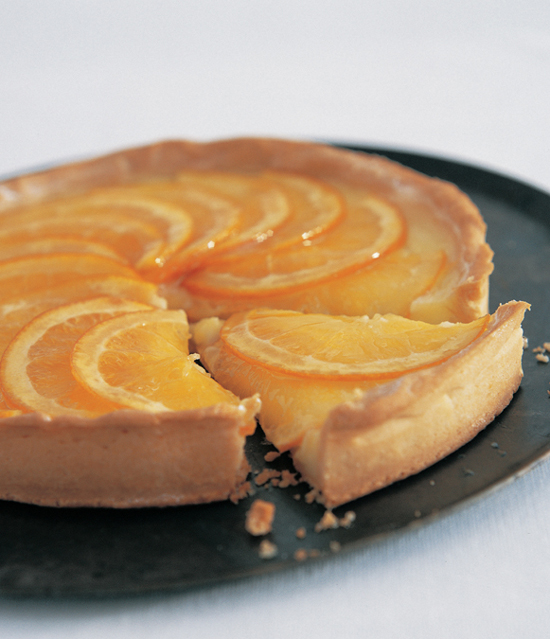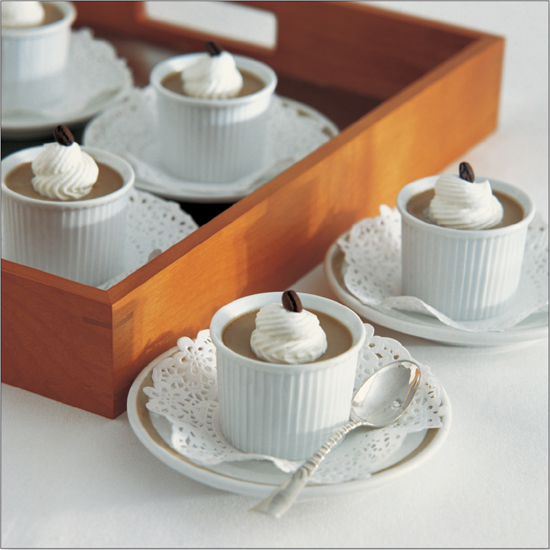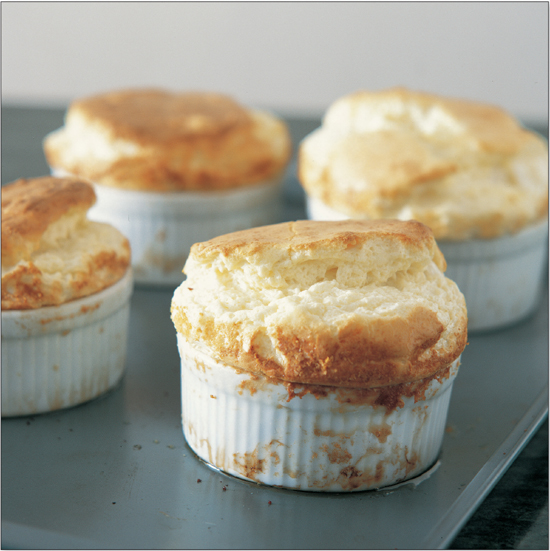CUSTARDS, SOUFFLÉS,
FRUIT CURDS, AND
MOUSSES
Methods and Techniques
This is a chapter of spoonable, even spreadable, desserts. Most are baked, but several are made on the stovetop (mousses, curds), and these typically have versatile and various uses—for example, mousses are capable of being served on their own or used as a filling for cakes, pies, or tarts.
A custard is a liquid or semiliquid mixture that is combined with eggs or egg yolks and then gently cooked until it sets—either on the stovetop in a double boiler or in the oven in a bain marie, or water-filled baking pan. Virtually any sweet or savory mixture can be combined with beaten egg—one egg sets about ⅔ cup of mixture—and baked into a custard.
While terrifying to many cooks, not too much can go wrong with a soufflé. You need only be careful with the egg whites—make sure the bowl is dry and grease free and there is not a speck of yolk anywhere—and avoid overcooking the soufflés, which causes them to fall the instant they come out of the oven.
Most of us adore chocolate mousse served alone, but many of us don’t realize that mousses can be used as fillings for cakes. In French, mousse means froth or foam: Shaving cream and the foam on the ocean are both mousses. Chocolate mousse makes a beautiful filling for cakes: While deeply flavorful, it’s lighter than buttercream because it contains air.
Fruit curds, especially lemon curd, are among the most popular tart fillings because they’re light and sweet without being too sweet and because they provide a tangy and refreshing accent to the fruit. They can also be used as a spread on scones or other breads, or folded together with whipped cream to make a mousse.
Most familiar custards are sweet custards such as crème caramel, crème brûlée, and pots de crème. Custards can be made with fruit juices or purees and baked in tarts like those those in the section on fruit custard pies and tarts. While the most common dessert custards are made in virtually the same way, they have varying consistencies depending on whether they’re made with milk, cream, or a mixture of milk and cream and whether they’ve been set with whole eggs, egg yolks, or a mixture of the two. The pots de crème are made with a mixture of milk and cream set with egg yolks; the crème caramel is made with milk and whole eggs plus egg yolks; and, the richest of all, crème brûlée is made with all cream and egg yolks.
Once the ingredients for the custards have been combined, they’re gently baked, usually in a bain marie, which helps the custards cook evenly and keeps them from overheating and curdling. While vanilla is the most popular sweet-custard flavoring, the possibilities are limitless. You can flavor custards with ground spices such as ginger or cinnamon; spirits such as rum, Cognac, or kirsch; fruit purees such as raspberry; chocolate; or coffee.
Coffee Pots de Crème
Pots de crème (pronounced poe de krem) get their name from the little pots with lids that are traditionally used to bake the custard. Since these are expensive and have only one use, you can use small ramekins instead. Because pots de crème are made with a mixture of milk and cream, they are halfway in richness between crème caramel and crème brûlée. These pots de crème are flavored with coffee, which is easiest to do by whisking some instant coffee into the hot milk and cream. However, a much deeper coffee flavor is extracted by infusing the hot milk and cream with ground coffee and then straining it out.
MAKES SIX 4-OUNCE POTS DE CRèME
1 cup heavy cream
1 cup milk
¼ cup freshly ground dark roast coffee
½ cup sugar
7 egg yolks
½ cup heavy cream
2 teaspoons sugar
6 espresso beans
Preheat the oven to 300°F. Combine the cream, milk, and coffee in a heavy-bottomed saucepan. Bring the mixture to a simmer over medium heat and let steep, off the heat, for 10 minutes. Strain into a bowl through a fine-mesh sieve. In a bowl, whisk the sugar and egg yolks for about 2 minutes, or until the mixture is slightly pale. Use the whisk to stir in the cream mixture. Continue stirring until there is no egg yolk clinging to the sides of the bowl. Strain again and pour the mixture into six 5- or 6-ounce ramekins or pot de crème cups with lids. If using ramekins, cover each of them with a small sheet of aluminum foil to prevent a crust from forming on top of the custard.
Put the custards in a baking dish with high sides and pour in enough hot water—the hottest water from the tap will do—to come about halfway up the sides of the ramekins. Bake for about 40 minutes, or until the custards have set. To check, remove the foil from two of them—choose two from different positions in the baking dish—and gently move them back and forth. When you no longer see the liquid moving, the custards have set.
Remove the custards from the baking dish. Allow to cool to room temperature. Refrigerate for at least 2 hours. Don’t be tempted to stick them in the refrigerator while still warm or moisture will condense on the underside of the foil and drip down onto the custards.
To garnish, beat the cream and sugar to stiff peaks. Serve the pots de crème with a swirl of whipped cream and an espresso bean on top.

1. Combine the cream, milk, and ground coffee in a saucepan and bring to a simmer. Let steep for 10 minutes. Strain the cream mixture.

2. While the cream mixture is coming to a simmer, whisk the egg yolks with sugar for about 2 minutes, or until pale. Gently stir the hot cream mixture into the beaten egg yolk mixture.
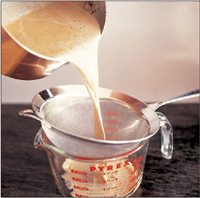
3. Strain the mixture one more time.
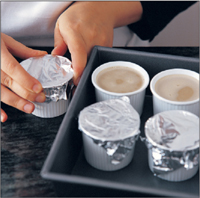
4. Pour the mixture into the ramekins, then cover each of the filled ramekins with aluminum foil. Place the ramekins in a baking dish and pour in enough hot tap water to come halfway up the sides of the ramekins. Bake until set. Cool, refrigerate, and serve.
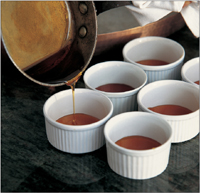
1. Line the bottoms of the ramekins with caramel.
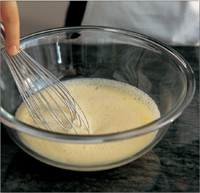
2. Beat together the sugar, eggs, and egg yolks.

3. Bring the milk and vanilla to a simmer and pour it into the egg mixture while stirring—not beating—with a whisk. Stir until smooth and the milk is completely incorporated. If while stirring you’ve generated a lot of froth, skim it off with a bench scraper.

4. Strain the mixture.
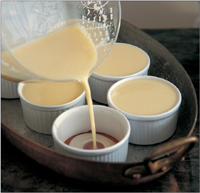
5. Fill the ramekins with the egg mixture.
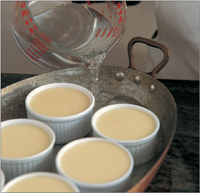
6. Place the ramekins in a baking pan and pour in enough hot water to come halfway up their sides. Bake until the custards have set.
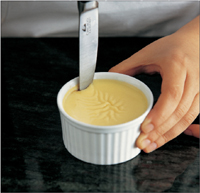
7. Take the custards out of the water bath and refrigerate for at least 3 hours. Run a knife around each of the custards to loosen them.

8. Put a plate over a crème caramel and, while holding the ramekin firmly against the plate, flip the whole thing over. Give it a quick up and down shake while still holding firmly and lift off the ramekin.
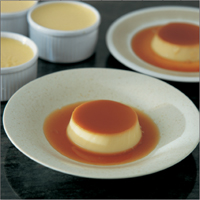
9. A little pool of caramel will surround the custard. Serve cold.
Crèmes Caramels
Crème caramel is the least rich of the sweet custards because it is made with milk and whole eggs—or whole eggs with a small number of additional yolks—but with no cream. It gets its name, of course, from the caramel used to line the ramekins in which the custards are baked. The custards are baked in a bain marie—a shallow pan filled partway with water—to keep them from overheating.
MAKES SIX 6-OUNCE CRÈMES CARAMELS
2 cups sugar
3 cups milk
2 teaspoons vanilla extract
4 whole eggs
2 egg yolks
Preheat the oven to 325°F. Using 1½ cups of the sugar, prepare the
caramel (see method). Pour just enough caramel into six 6-ounce ramekins to cover the bottoms with a thin layer. Avoid getting any on the sides of the ramekins.
Bring the milk to a simmer in a heavy-bottomed saucepan. Add the vanilla. In a bowl, whisk the remaining ½ cup sugar with the eggs and egg yolks for about 2 minutes, or until the mixture is slightly pale. Use a whisk to stir the hot milk into the egg mixture and stir until the eggs are completely combined with the milk. If you see a lot of froth on the mixture, skim it off with a pastry scraper. If you see specks of egg in the mixture, strain it through a fine-mesh sieve.
Pour the mixture into the caramel-lined ramekins and arrange the ramekins in a baking dish with sides at least as high as the ramekins. Pour enough hot tap water into the baking dish to come halfway up the sides of the ramekins. Bake for about 50 minutes, or until the surface of the custards stay still when you wiggle them back and forth.
Allow to cool for 1 hour at room temperature and then refrigerate for at least 2 hours.
Run a knife around each of the custards to loosen them. Put a rimmed plate over a crème caramel and, holding the ramekin firmly against the plate, flip the whole thing over. Give it a quick up and down shake while still holding firmly and lift off the ramekin. Serve cold.
Many recipes for caramel combine sugar with water before the mixture is heated. Because the water has to evaporate completely in order for the sugar to caramelize, this just wastes time. Instead, put the sugar in the pan over the heat and stir it until it turns a deep red. Caramel
syrup, caramel
sauce, and
butterscotch sauce are easily fashioned from this basic sauce.
To make 1 cup of caramel, place 2 cups sugar in a heavy-bottomed saucepan over medium to high heat and stir continuously with a heavy wooden spoon as the sugar melts and turns color. The caramel is ready when it is smooth and deep reddish-brown in color.
Unless you’re
making one of the caramel sauces shown in the Variations (right), dip the bottom of the pan into a bowl of cold water for about 1 second, to stop the cooking but not so long that the caramel hardens. Use immediately.
Pour 1 cup water into 1 cup hot caramel (stand back, it spatters). Bring it back to a boil and simmer, while stirring, until all the caramel has dissolved into the syrup. Makes 2 cups.
Add 1 cup heavy cream to 1 cup hot caramel (stand back, it spatters). Stir until the sauce is smooth and evenly colored. Adjust the consistency by adding more cream to thin the sauce or by boiling the sauce down a couple of minutes to thicken the sauce. Makes 1⅔ cups.
Add ¾ cup butter to 1 cup hot caramel (stand back, it spatters) and stir until the butter melts and the mixture is smooth. Continue stirring over medium heat for about 1 minute, or until the mixture smells like butterscotch. Add 1 cup heavy cream and stir until smooth. Simmer the sauce until it has the consistency you like. If it’s too thick, thin it with 1 to 2 tablespoons water.

1. Put the sugar in a heavy-bottomed saucepan over medium to high heat.
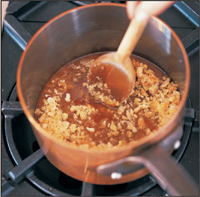
2. Continuously stir the caramel with a heavy wooden spoon…

3.…until there are no lumps.

4. To make caramel sauce, pour heavy cream into the hot caramel. Stand back. Stir with a wooden spoon until smooth.
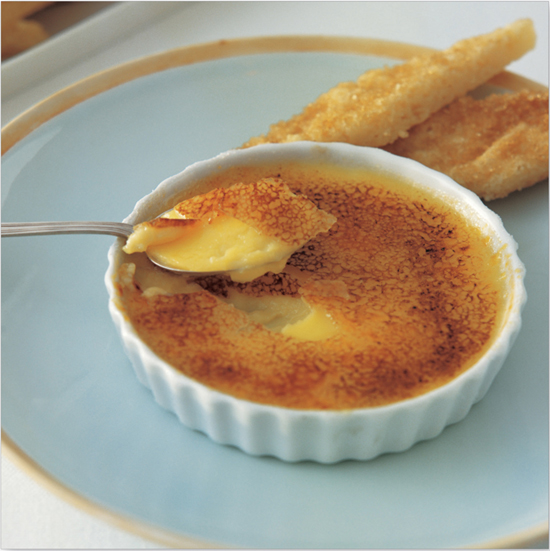
Crèmes Brûlées
Crème brûlée is made with the same basic ingredients as pots de crème heavy cream and egg yolks—but is flavored with a whole vanilla bean and finished with a top layer of crunchy caramel.
MAKES SIX 5-OUNCE CRèMES BRÛLÉES
2 cups heavy cream
1 vanilla bean, split in half lengthwise, or 2 teaspoons vanilla extract
6 egg yolks
1 cup sugar
Preheat the oven to 300°F. In a heavy-bottomed saucepan, bring the cream to a simmer with the vanilla bean or vanilla extract. If using a vanilla bean, scrape out the tiny seeds from each half and stir them into the cream.
In a bowl, whisk the egg yolks and ½ cup of the sugar for about 2 minutes, or until slightly pale. Stir the hot cream into the yolk mixture. Continue stirring until no yolk clings to the sides of the bowl.
Arrange six 5-ounce crème brûlée dishes or ramekins in a jelly roll pan or shallow roasting pan and pour in the custard mixture. Pour enough hot tap water into the pan to come halfway up the sides of the dishes. Bake for about 40 minutes, or until the custard doesn’t jiggle when you gently move the dishes.
Take the custards out of the jelly roll pan and let cool at room temperature for 1 hour. Refrigerate for at least 4 hours.
Within an hour of serving, sprinkle the remaining ½ cup sugar over the custards so they are covered evenly with a thin layer. Tilt a blowtorch over each crème brûlée with the flame a couple of inches away from the top. Move the torch around until the sugar melts and forms a transparent sheet. Serve.
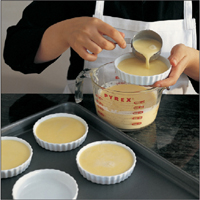
1. Prepare the ingredients exactly the same way as for crème caramel, but instead of whole eggs, use egg yolks; and instead of milk, use heavy cream. Fill the dishes as close to the top as you can.
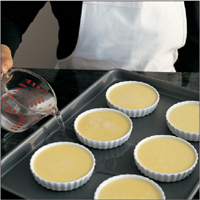
2. Place the custards in a jelly roll pan or shallow baking pan and pour in enough hot tap water to come about halfway up the sides of the molds. Bake until firm when jiggled. Refrigerate for at least 4 hours.
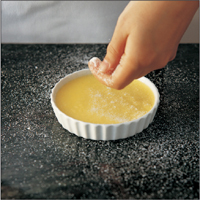
3. Sprinkle the custards with just enough sugar to form a thin layer with no gaps in it.
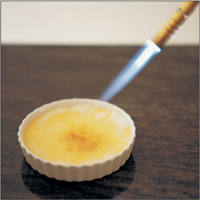
4. Wave a blowtorch over the custards. Don’t hold the torch too close or the surface won’t caramelize evenly.
While the principles of making sweet and savory soufflés are the same—beaten egg whites are folded with a denser mixture that provides flavor and substance—savory soufflés are based on béchamel sauce and sweet soufflés are based on pastry cream or sabayon, a fluffy mixture made with egg yolks. And while soufflés have to be served as soon as they’re baked, the molds can be floured or sugared and the base mixture can be made ahead of time so that the only last-minute work is beating the egg whites, folding them with the base mixture, and baking.
Though not essential, an aluminum-foil collar wrapped around the soufflé dishes before baking prevents any loose and still-runny soufflé mixture from spilling down the sides as the soufflé heats and expands. The collar itself must be buttered and floured (or sugared or coated with grated Parmesan cheese), so the soufflé mixture doesn’t stick to it. Don’t bother with collars if your soufflé dishes are less than full. For the most dramatic soufflés, use smaller molds so the filling actually comes up over the rims before baking and use collars to hold the filling in place.
Cheese Soufflés
Cheese Soufflés
A cheese soufflé is the most satisfying of all savory soufflés and also provides a model for making savory soufflés out of just about anything. The model is simple: Make a béchamel sauce—essentially, milk thickened with a little flour—and combine it with cheese and egg yolks. Beat egg whites to stiff peaks and fold them with the béchamel mixture while folding over additional grated cheese—ideally, a dry cheese such as Parmigiano-Reggiano that grates very fine. Spoon the mixture into individual soufflé dishes that have been buttered and coated with grated cheese or flour. If your soufflé dishes are 10 ounces or larger, there is no need to make collars. If, however, they’re smaller—say 8 ounces—make 4 aluminum foil collars out of 4 sheets of aluminum foil, each about 4 times as long as the diameter of the dishes, by folding the sheets lengthwise in thirds. The strips should be wide enough to come about 2 inches over the rim of the soufflé dish. Bake the soufflés until they rise 1 to 2 inches out of the dishes. Jiggle one to see if it seems stiff or fluid—this takes some practice—and probe into the soufflé with a spoon. It should be slightly runny in the very center.
MAKES 4 INDIVIDUAL SOUFFLÉS
2 tablespoons butter, at room temperature, for dishes plus 3 tablespoons if using collars
5 tablespoons finely grated authentic Italian Parmesan or other dry cheese for dishes plus ½ cup if using collars
3 tablespoons butter
3 tablespoons flour
¾ cup milk
Tiny pinch or grating of nutmeg
¼ teaspoon salt
5 grinds of pepper
4 egg yolks
5 ounces Gruyère or other firm cheese, grated (about 1 cup)
7 egg whites
Pinch of cream of tartar, unless using a copper bowl
2 ounces authentic Italian Parmesan or other dry cheese such as aged Gouda, grated (about ¾ cup lightly packed)
To prepare the soufflé dishes and collars if using, brush the soufflé dishes and the collars with butter. You don’t need to brush the entire strips of aluminum foil, just that part that will reach above the dishes. Coat the dishes and buttered parts of the collars with the grated cheese.
To make the béchamel base, combine the butter and flour in a heavy-bottomed saucepan over medium heat and stir for about 2 minutes, or until smooth. Add the milk and stir the mixture with a whisk for about 5 minutes, or until it boils and thickens. Whisk until smooth. Add the nutmeg, salt, and pepper. Stir the sauce for 1 minute to cool slightly. Whisk in the egg yolks. Add the Gruyère cheese and stir the sauce until smooth.
To finish the soufflés, preheat the oven to 350°F. Beat the egg whites with the cream of tartar (if using) to stiff peaks. Combine about one-fourth of the egg whites with the base to lighten it. Fold the base with the rest of the egg whites, while sprinkling over the Parmesan cheese.
Distribute the soufflé mixture among the dishes. If the soufflé mixture comes slightly over the tops of the dishes, smooth off the tops with the back of a knife. Make a small moat around each of the soufflés with your thumb to keep the filling from sticking. Wrap around the collars. Pinch the ends of the collars together where they meet to hold them in place.
Put the soufflés on a sheet pan, turn up the oven to 375°F, and bake for about 18 minutes, or until risen 1 to 2 inches above the rims of the dishes. Stick a spoon through the side into the center of one of the soufflés. The soufflé should be very slightly runny in the very middle. Pull away the collars and serve.
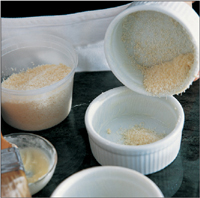
1. To prepare the molds, brush the soufflé molds with butter and coat the molds with the grated Parmesan cheese.
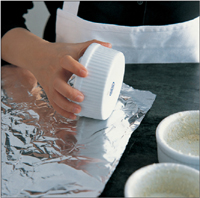
2. For collars: Cut four strips of aluminum foil about 4 times as long as the soufflé dishes are wide. Fold the strips in thirds lengthwise. The collars should be 1 to 2 inches wider than the soufflé dish is high.
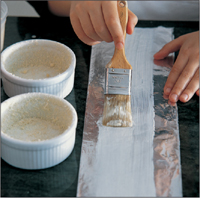
3. Brush the collars with butter—don’t butter the entire strip, just the part that will be above the dish.

4. Sprinkle the collar with the grated Parmesan.

5. Tap off the excess cheese.
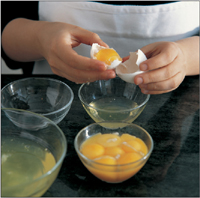
6. To make the béchamel sauce, separate the eggs by moving the egg back and forth between the two halves of the broken shell while letting the white drop down into a bowl.
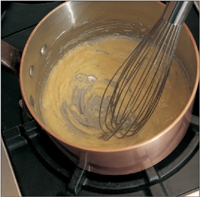
7. Melt the butter in a heavy-bottomed saucepan. Stir in the flour, whisk to eliminate lumps, and cook the flour for about 2 minutes.
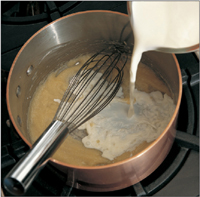
8. Whisk the milk into the flour-butter mixture (a roux), about one-fourth at a time. Wait until the mixture thickens before adding more.

9. Continue adding milk and whisking to keep the sauce smooth and free of lumps.
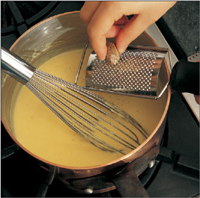
10. Grate in nutmeg and add salt and pepper.

11. When the béchamel has thickened, take it off the heat and whisk it for a minute or so to cool it. Add the egg yolks and stir until smooth.
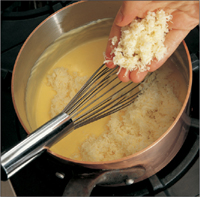
12. Whisk in the Gruyère cheese and stir until the sauce is smooth.
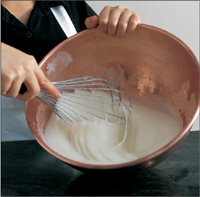
13. To finish the soufflés, beat the egg whites to stiff peaks (add cream of tartar, unless you are using a copper bowl).
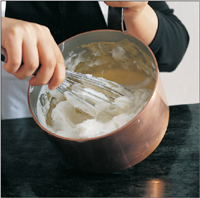
14. Whisk about one-fourth of the beaten egg whites into the base to lighten it.

15. Add the base to the egg whites and fold together.
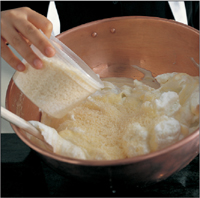
16. While folding together the base and egg whites, sprinkle over the Parmesan cheese.

17. Fill the prepared dishes.
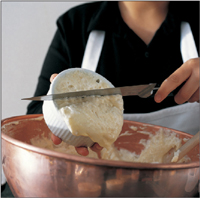
18. Smooth off the tops of the soufflés with the back of a knife or with a metal spatula.
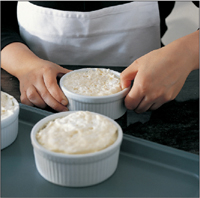
19. Make a small moat around the rim of the soufflés with your thumb.

20. Wrap the collars around the soufflés.
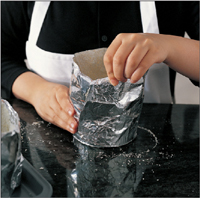
21. Attach the collars by folding over a little bit of one end with the other.
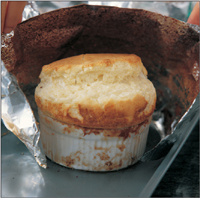
22. Bake until the soufflés come about 2 inches above the rim of the dishes. Quickly remove the collars and serve.

Grand Marnier Soufflés
When making a Grand Marnier soufflé or, for that matter, any soufflé, the purpose is to get as much flavor as possible into the base without making the base too thin. If the base is too thin, it won’t support the egg whites and the soufflé may fall. These soufflés are based on a sabayon sauce, which is essentially a mixture of egg yolks, sugar, and flavorful liquid that is beaten over heat until it thickens, but isn’t allowed to get hot enough to curdle. In this recipe, a little cornstarch is added to thicken the sabayon, but not nearly as much as would be included in a classic dessert soufflé made with a pastry cream base.
These soufflés use as many ways as possible to emphasize the orange flavor. In addition to Grand Marnier, orange juice, orange zest, essential orange oil, and homemade candied orange peel macerated in additional Grand Marnier are used. The candied orange peel and the orange oil help reinforce the orange flavor, but are not essential.
Because this soufflé mixture is fairly stiff, you can make these soufflés without collars.
MAKES 6 INDIVIDUAL SOUFFLÉS
3 tablespoons butter, at room temperature, for dishes
¼ cup superfine sugar, for dishes
3 tablespoons candied orange peel
3 tablespoons Grand Marnier plus 1 tablespoon if using candied orange peel
1 tablespoon grated orange zest
Juice from 1 orange
1 teaspoon essential orange oil (optional)
5 egg yolks
1 teaspoon cornstarch
2 tablespoons granulated sugar
8 egg whites
Pinch of cream of tartar, unless using a copper bowl
¼ cup plus 2 tablespoons superfine sugar
Preheat the oven to 400°F. To prepare the dishes, brush six 7-ounce soufflé dishes or large ramekins with the butter and coat with the superfine sugar. Refrigerate until needed.
To make the sabayon base, cut the candied orange peel into ¼-inch dice and soak in the 1 tablespoon Grand Marnier for 30 minutes. Combine the orange zest and juice, orange oil, the 3 tablespoons Grand Marnier, the egg yolks, cornstarch, and granulated sugar in a heavy-bottomed saucepan, ideally one with sloping sides. Whisk over medium heat for about 2 minutes, or until the mixture is light and fluffy and then stiffens. Be careful to reach into the corners of the pan with the whisk so that egg doesn’t accumulate in there and curdle. Don’t let the mixture boil. Whisk for 2 minutes off the heat to cool the mixture and so the heat retained in the pan doesn’t cause the base to curdle. Add the candied orange peel with the soaking liquid.
To finish the soufflés, beat the egg whites with the cream of tartar (if using) to medium peaks and add the superfine sugar. Beat to stiff peaks. Fold the egg whites with the base and distribute the mixture among the soufflé dishes. Smooth off the tops of the soufflés and make a small moat around the rim of each dish with your thumb to keep the filling from sticking.
Bake the soufflés for about 15 minutes, or until they rise about 1½ inches above the rims of the dishes. Reach through the side of one of the soufflés with a spoon to check the center. The very center should be loose and a tiny bit runny. If it’s not, bake for 3 minutes more and check again. Serve.
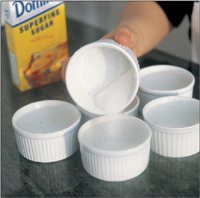
1. Brush the soufflé dishes or ramekins with butter. Coat the dishes with superfine sugar by putting the sugar in one of the dishes and rotating it over the next dish.

2. Zest the orange before you juice it.

3. Squeeze the orange over a strainer set in a saucepan, preferably one with sloping sides.

4. Cut the optional candied orange peel into ¼-inch dice. In a bowl, macerate the orange peel in the 1 tablespoon Grand Marnier.
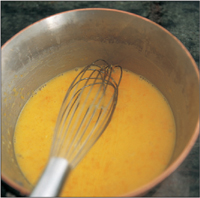
5. Combine the orange zest, orange juice, orange oil, the 3 tablespoons Grand Marnier, egg yolks, cornstarch, and granulated sugar in a saucepan. Whisk the mixture together, off the heat, until well mixed.
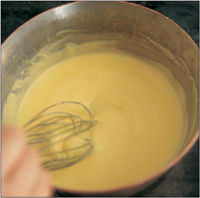
6. Whisk over medium heat until the mixture thickens; don’t let it boil.

7. Whisk the mixture for 2 minutes off the heat to cool it and stir in the candied orange peel with the soaking liquid.
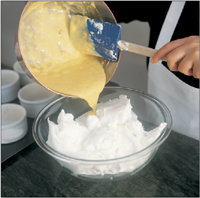
8. Beat the egg whites (and cream of tartar, if using) to medium peaks, add the sugar, and beat to stiff peaks. Transfer the whites to a bowl as shown here or fold in the bowl you used for beating the whites. Pour the sabayon mixture over the beaten whites.

9. Fold until well combined.

10. Use a rubber spatula to fill the soufflé dishes or ramekins. Smooth over the tops of the soufflés to even them off and make sure they’re full.
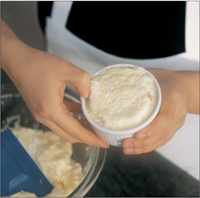
11. Run your thumb around the edge of the dishes to make a small moat. Bake until the soufflés are just a tiny bit runny inside and the mixture has risen about 1½ inches over the rims of the dishes.
Eggs, sugar, and fruit juice or puree are the essential ingredients of fruit curds—though butter is often added to round out the flavor. Lemon curd is a popular filling for tarts, and it and other fruit curds can be used to fill cakes or to flavor buttercream or mousseline. Folded together with whipped cream, fruit curds make wonderful mousses which can be served chilled on their own or used as cake fillings. They are also nice spreads for scones or other baked goods.
Lemon Curd
Lemon curd is like the filling in a lemon meringue pie but without all the starch. At its best, it’s tangy and sour and creamy, which makes it perfect when juxtaposed with richer or sweeter components such as meringue. This is the most basic of lemon curds. Many recipes call for butter. While not essential, the butter softens the fruit’s sharp acidity. You can also use browned butter (beurre noisette), which gives the curd an intense and delicious butterscotch flavor and makes the curd somewhat stiffer once it cools.
MAKES 1½ CUPS, ENOUGH FOR TWO 9-INCH ROUND CAKE LAYERS
2 eggs
½ cup sugar
1 tablespoon grated lemon zest
⅓ cup lemon juice
4 tablespoons butter, cubed or sliced (optional)
Combine the eggs, sugar, zest, and juice in a heatproof bowl that fits over a saucepan. Whisk until smooth and slightly pale.
Place the bowl over a saucepan of simmering water and stir with a whisk. As the mixture warms, add the butter, a handful at a time, and continue stirring. Whisk the mixture over the heat until it thickens, taking care not to let it boil.
Spread in a cake, or let it cool, then whisk with other mixtures such as buttercream or crème mousseline.
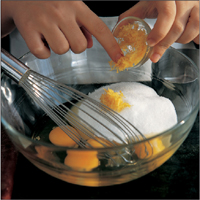
1. Combine all of the ingredients except the butter in a heatproof bowl that fits at least partially in a saucepan. Whisk until smooth and slightly pale.
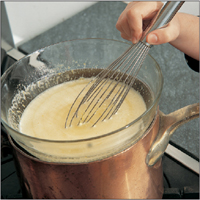
2. Put the bowl over a saucepan of simmering water and stir with a whisk.

3. As the mixture warms, add the butter and continue stirring.
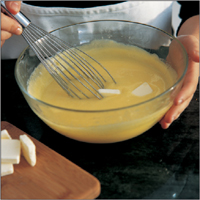
4. Whisk the mixture over the heat until it thickens, but don’t let it boil.
Because it is so acidic, passion fruit curd is much like lemon curd. The amount of sugar needed varies depending on the sweetness of the fruit. Passion fruit puree is very tart, so this recipe calls for a lot of sugar. If you’ve made a curd and it is not sweet enough, you can sweeten it with corn syrup or, if the curd is the base for a mousse, by oversweetening the whipped cream. Passion fruit curd can be used as a layer in a cake, or it can be combined with buttercream or crème mousseline to add tang.
MAKES 3 CUPS, ENOUGH FOR THREE 9-INCH ROUND CAKE LAYERS
1 cup strained passion fruit puree
4 eggs
1 cup sugar
½ cup butter, cubed or sliced (optional)
Place the puree in a nonreactive saucepan and bring it to a simmer. Set aside.
Combine the eggs and sugar in a heatproof bowl that fits over a saucepan. Whisk until smooth.
Place the bowl over a saucepan of simmering water and stir with a whisk. As the mixture warms, add the butter, a handful at a time, and continue stirring until the curd thickens slightly. It should remain liquid. Because it contains so much butter, the curd will thicken when cold. Strain the mixture while it is still warm.
Cover the mixture with plastic wrap; be sure the plastic wrap is touching the surface of the curd, or a skin will form. Use as a cake filling or combine with other mixtures such as buttercream or crème
mousseline.
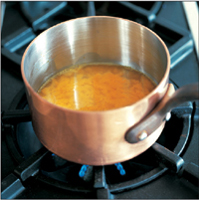
1. Place the passion fruit puree in a saucepan and bring it to a simmer.
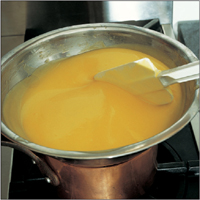
2. Whisk together the eggs and sugar in a wide bowl until smooth. Place the bowl over a saucepan of simmering water and add the butter. Stir with a whisk or rubber spatula until it thickens but remains liquid. The curd will thicken when chilled.
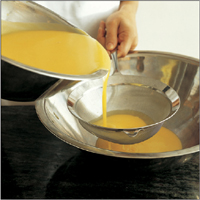
3. Strain the mixture while it is still warm.

4. Cover the curd with plastic wrap; be sure the plastic wrap is touching the surface of the curd, or a skin will form.
To turn a fruit curd into a fruit mousse, fold in whipped cream. If you’re not using the mousse right away and serving it within a day, add gelatin as we do here to keep it from separating. Note: Whenever you combine tropical fruit with gelatin, bring the tropical fruit puree to a simmer before you add the gelatin. This kills protease enzymes that would otherwise interfere with the gelatin setting. This mousse can be used to make napoleons.
MAKES 5 CUPS, ENOUGH FOR THREE 9-INCH ROUND CAKE LAYERS
4½ teaspoons (1½ packets) powdered unflavored gelatin
¼ cup water
3 cups passion fruit curd (opposite page)
1½ cups heavy cream
3 tablespoons sugar
Put the gelatin and water in a small bowl and let sit for about 10 minutes, or until it swells, or blooms, and absorbs the water. Stir the softened gelatin with a fork to get rid of any lumps. Then put the bowl over a saucepan of simmering water until the gelatin dissolves.
Place the passion fruit curd in a nonreactive saucepan and bring it to a simmer over medium-low heat. Pour the melted gelatin into the still-hot fruit curd and mix thoroughly with a whisk. Set aside until the curd feels neither hot nor cold.
Whip the cream to medium peaks, beating in the sugar. Fold the whipped cream into the curd mixture. Immediately place in serving dishes and chill, or use to fill a cake or pastry.
Dark chocolate mousse is made foamy with beaten eggs, egg whites, and whipped cream, either alone or in combination. Traditional mousse recipes call for beating egg yolks with melted chocolate, sometimes melted with butter, but because of egg anxieties, in modern recipes the egg yolks are cooked. Because egg whites are considered safer than egg yolks, recipes that call for cooking the yolks often include raw beaten egg whites. To avoid raw egg whites, use whipped cream or Italian meringue.
To make the simplest mousse, melt chocolate and butter with a liquid flavoring such as vanilla, coffee, liqueur, or eau de vie. Use at least one-fourth as much liquid as you have chocolate—any less, and the chocolate may seize and stiffen up into a grainy mess; too much liquid and the mousse may end up too runny. Once you have your chocolate base, simply fold it with sweetened beaten egg whites (raw, or cooked as Italian meringue) or whipped cream.
To use egg yolks, which give a mousse a creamy consistency and help the mousse hold its shape, combine them with the liquid flavoring and whisk them over a pot of barely simmering water until they get frothy and stiffen into what the French call a sabayon or the Italians, when Marsala wine is used as the flavoring, a zabaglione. Then, melt the chocolate directly into the sabayon or melt it separately, alone, or with butter, and stir it into the finished sabayon. The chocolate sabayon mixture is then folded with beaten egg whites, whipped cream, or both.
Chocolate mousse is easy to serve alone—pour it while still warm into wineglasses or just spoon it out onto plates—but it also makes an excellent cake filling.
When small amounts of liquid are added to melted chocolate, the chocolate coagulates and turns granular, a condition known as “seizing.” The mixture can be repaired only by adding more liquid. The higher the cocoa content of the chocolate, the more liquid is required to make it smooth when melted. While you can use water to thin out seized chocolate, it is better to use heavy cream when you are
making a mousse. Use as little cream as possible to smooth out the chocolate—too much and you’ll thin the mousse so it never sets; too little and it will stay grainy.
Classic Chocolate Mousse
This chocolate mousse is made by cooking egg yolks over a saucepan of barely simmering water before combining them with other ingredients. The trick is to get the egg yolks hot enough to kill any bacteria, but not so hot that they curdle. The best way to judge the temperature is with an instant-read thermometer, which should reach 150°F. In this recipe, a small amount of sugar is beaten into the egg yolks to stabilize them, so they’re less likely to curdle.
MAKES 3 CUPS, ENOUGH FOR THE INSIDE LAYERS OF A 4-LAYER 9-INCH ROUND CAKE
6 ounces bittersweet chocolate, chopped
¼ cup plus 2 tablespoons butter, cubed or sliced
4 egg yolks
3 tablespoons sugar
1 teaspoon vanilla extract, or 2 tablespoons Cognac, rum, or kirsch
1 cup heavy cream for whipping or more as needed to thin the chocolate mixture
Combine the chocolate and butter in a heatproof bowl. Set the bowl over a saucepan of barely simmering water and stir with a wooden spoon or whisk until melted and smooth. Take the bowl off the heat, leaving the saucepan of simmering water on the stove.
Combine the egg yolks and sugar in a heatproof bowl and set it over the saucepan of barely simmering water. Whisk for about 5 minutes, or until pale and slightly stiff. Remove from the heat. Stir the chocolate mixture into the egg yolks, add the vanilla, and stir until well mixed. If at this point the mixture becomes stiff or grainy, whisk in heavy cream or water, ¼ cup at a time, until the mixture is smooth (see sidebar, left). Stir for a few minutes to cool. Let cool to room temperature.
Whip the cream to soft peaks. Stir about one-fourth of the whipped cream into the chocolate mixture and then fold in the rest with a rubber spatula.
If you are using the mousse as a layer in a cake, you can use it right away provided you are making your cake in a springform pan or cake ring, which will hold the mousse in place; otherwise, chill the mousse for at least 1 hour before you use it. If you are serving the mousse alone, chill for at least 1 hour before serving unless you are serving it in glasses, which should be filled before chilling. When chilling mousse, cover it with plastic wrap against the surface to keep a dark crust from forming.

1. Combine the egg yolks and sugar in a metal bowl set over a saucepan of barely simmering water. Beat with a whisk until the mixture is pale and slightly stiff, adding heavy cream as necessary to make it smooth.
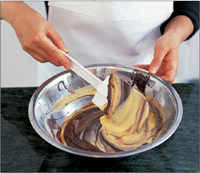
2. Add the melted chocolate mixture and flavoring to the egg mixture. Stir and let cool to room temperature.
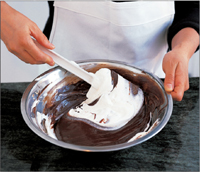
3. Fold the whipped cream into the chocolate-egg mixture, adding cream or water to thin if it turns grainy.
White chocolate can be substituted for dark chocolate in many mousse recipes, but because mixtures made with it are more likely to be runny, gelatin is often added to the mousse to help it set.
White chocolate mousse makes a great cake filling, as does whipped white chocolate ganache. One caveat: Some brands of white chocolate may turn grainy when you heat them. I’ve had continued success with Lindt brand white chocolate.
MAKES 2½ CUPS, ENOUGH FOR THE INSIDE LAYERS OF A 3-LAYER 9-INCH ROUND CAKE
1 teaspoon (⅓ packet) powdered unflavored gelatin
¼ cup cold water
1½ cups heavy cream
7 ounces white chocolate, chopped
Put the gelatin and cold water in a small bowl and let sit for about 10 minutes, or until it swells, or blooms, and absorbs the water. Stir the softened gelatin with a fork to get rid of any lumps.
Bring ½ cup of the cream to a simmer in a small saucepan and stir in the gelatin and its soaking liquid. Off the heat, stir the mixture until the gelatin completely dissolves.
Pour the hot gelatin mixture over the white chocolate in a heatproof bowl and stir until all the chocolate melts. If it doesn’t entirely melt, set the bowl over a saucepan of hot water for 30 seconds to 1 minute and stir some more. Don’t let the white chocolate get too hot; it has much less tolerance for heat than does dark chocolate and will coagulate if too hot. Remove from the heat and let cool for 5 minutes, or until no longer hot enough to melt the whipped cream but not cold enough to set. If it starts to set, heat it for a few seconds.
Beat the remaining cream to medium peaks. Pour the chocolate mixture into the bowl of whipped cream and fold until smooth with a rubber spatula. If you’re assembling a cake in a cake ring, use the mousse right away while you can still pour it. If you’re serving the mousse on its own, ladle or spoon it into bowls or glasses and chill in the refrigerator for at least 2 hours before serving.
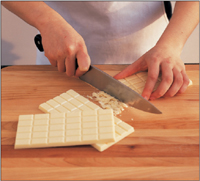
1. Chop the white chocolate. Pour the hot cream–gelatin mixture over the chopped chocolate to melt and stir until smooth. If the chocolate doesn’t melt, set the bowl over a saucepan of simmering water for 30 seconds to 1 minute and stir until smooth.

2. Whip the rest of the cream to medium peaks and fold in the white chocolate mixture.
A flourless cake is essentially a mousse that’s baked and, like a soufflé, allowed to fall in on itself after baking. Virtually all flourless cakes are made with chocolate, because the chocolate functions somewhat like flour and allows the cake to hold its shape. And like a chocolate mousse, air is incorporated by beating egg yolks with sugar, and beating the egg whites separately. Don’t worry if the cake cracks—it should—or if it’s a little runny in the center.
This recipe calls for frosting the cake with whipped ganache, but the cake is rich enough that a sprinkling of confectioners’ sugar is enough. Flourless chocolate cake is also great glazed with hot ganache or with chocolate glaze.
MAKES 1 ROUND LAYER CAKE (9 BY 1 INCH), OR 1 ROUND LAYER CAKE (8 BY 1½ INCHES)
Butter and flour for the pan
½ cup almond flour, or ⅔ cup blanched almonds
½ cup plus 2 tablespoons butter
3 ounces bittersweet chocolate, chopped
5 egg yolks
¾ cup plus 2 tablespoons sugar
4 egg whites
Pinch of cream of tartar, unless using a copper bowl
2 tablespoons Cognac (optional)
Preheat the oven to 350°F. Use a round cake pan either 9 by 1 inch or 8 by 1½ inches. For a springform pan, coat it liberally with butter and flour; for a regular cake pan, line the bottom with a round of parchment paper. If using blanched almonds, grind them to a powder in a food processor; set aside.
Combine the butter and chocolate in a stainless steel bowl and set it over a saucepan of simmering water. When the mixture has almost completely melted, remove the bowl from the heat and stir until smooth.
While the chocolate is melting, beat the egg yolks in a stand mixer on high speed with ¼ cup of the sugar for about 8 minutes, or until the egg yolks become pale and quadruple in volume. Using a rubber spatula, fold the egg yolk mixture with the chocolate-butter mixture. If the mixture turns thick and grainy, repair it as explained in the
sidebar.
Using a stand mixer on high speed, beat the egg whites with the cream of tartar (if using) for about 1 minute, or until soft peaks form. Add the remaining sugar and beat for about 1 minute more, or until medium peaks form. (Beating will take longer if you are using a whisk or hand mixer.)
Add the Cognac to the chocolate mixture and fold in the almond flour (or ground almonds). Stir in one-quarter of the egg whites to lighten the mixture, then fold in the remainder. Fold only long enough to make the mixture homogeneous.
Transfer the batter to the prepared cake pan, and bake for about 20 minutes. The cake is supposed to be loose in the middle, so a toothpick inserted in the center won’t come out clean.
Before you take the cake out of the pan, let it cool completely. Just before unmolding, place the cake pan over a burner on high heat and move it back and forth for about 15 seconds to loosen the cake. You can frost this cake with buttercream, but a dollop of whipped cream, passed at the table, is lighter.

1. Brush the inside of a springform pan liberally with room-temperature butter. Put flour in the pan and rotate it to coat the sides. Tap the pan against the work surface to loosen any excess flour.
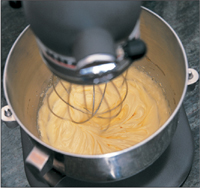
2. Combine the egg yolks in a bowl with ¼ cup of the sugar. Beat for about 8 minutes, or until the mixture is pale yellow and fluffy.

3. Place a bowl with the chopped chocolate and butter over a pan of simmering water. When the mixture has almost completely melted, take the bowl off the heat and continue to stir until smooth.
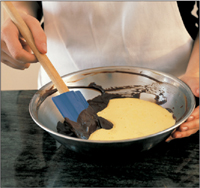
4. Fold the egg yolk mixture into the chocolate mixture with a rubber spatula.
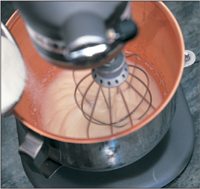
5. Beat the egg whites with the cream of tartar (if using) to soft peaks, then add the sugar and beat to medium peaks.
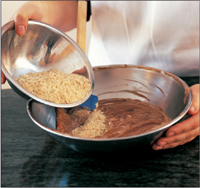
6. Fold Cognac (if using) into the chocolate mixture; fold in the almond flour.

7. Stir one-fourth of the egg whites into the chocolate mixture to lighten it, then fold in the rest of the egg whites. Fold just long enough to make the mixture homogeneous.

8. Transfer the mixture to the cake pan.
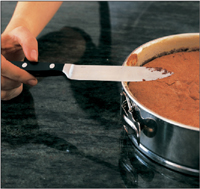
9. Bake until a knife comes out with crumbs attached to it—not until it is completely dry.

10. Frost the cake with
chocolate buttercream, if you like.
